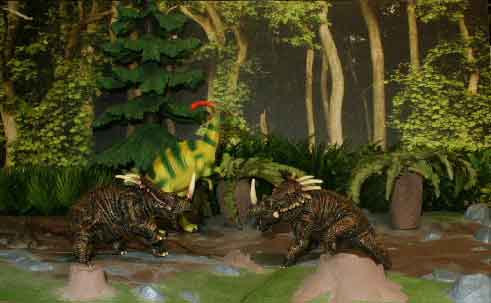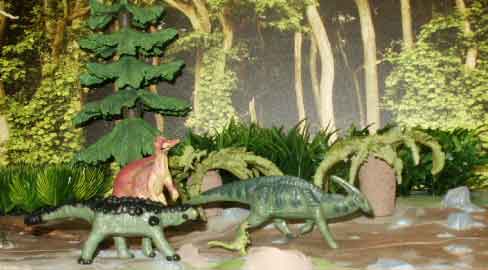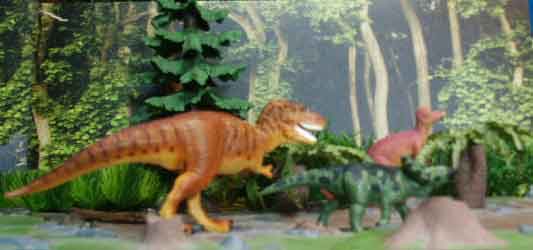
Late Cretaceous Campanian
Dinosaur Park
76.5 and 75 million years ago
from the Dinosaur Collector updated 09/12/08
Dinosaur Provincial Park includes much of the Judith River Formation in the Red Deer River area of
southern Alberta. Specimens of Gorgosaurus , Centrosaurus, Chasmosaurus and Styracosaurus have been found .
Gorgosaurus was related to Albertosaurus. Both tend to more commonly found in the southern ranges with lamborsaurines and centrosaurines are more common. This may implie that these longer legged predators specialised in chasing down these smaller fleeter animals.

Cog raptor, Wild Safari Gorgosaurus and Carneigie Corthyosaurus .
Styracosaurus was a relatively small at 18 feet, it was a horned dinosaur with a greatly extended neck frill and prominent nose horn. Large bone beds of centrosaurine and chamosaurine dinosaurs indicated that that at least at certain times they gathered together in great herds possibly for migrations like today's Caribou or Wildebeests. Styracosaurus (Spiked Lizard) is though to be a herding animal like its relative Centrosasurus.

Procon Styracosaurus and Parasaurlophus
Horned dinosaurs are dived into two major families the centrosaurines with Styracosasurus being the most popular and the chamosaurines that include the bigger and later Triceratops. The centrosaurines had large nasal horns and small frills generally. Chasmosasurines tended to have large frills and horns over the eyes being prominent. The Wild Safari Styracosaurus is a robust figure. Also included in the gray bin style vinyl figure from China.

Salas Euoplocehalus and Parasaurlophus from Mexico. Cog raptor and FunRise Corythosaurus.
Monoclonius one of the larger horned dinosaurs. The animals may have been very aggressive, based on a Pachyrhinosaurus skull with a severe head injury, evidence for which was apparent in that an extensive defect had scarred the right side of the face. It was determined that the animal most likely to have caused such a wound was a specimen of Monoclonius; Fossils are rare and most restorations are based on the better known Centrosaurus. The main difference being the lack of hooks at the top of the frill characteristic of Centrosaurus. Centosaurines disappear from fossil record in the later Maastrichtian.

Wild Safari Gorgosaurus, Salas Centrosaurus and FunRise Corythosaurus.
return to Mesozoic Menu
Click on the Site A icon to the right for Dioramas organized by period or by manufacturer.